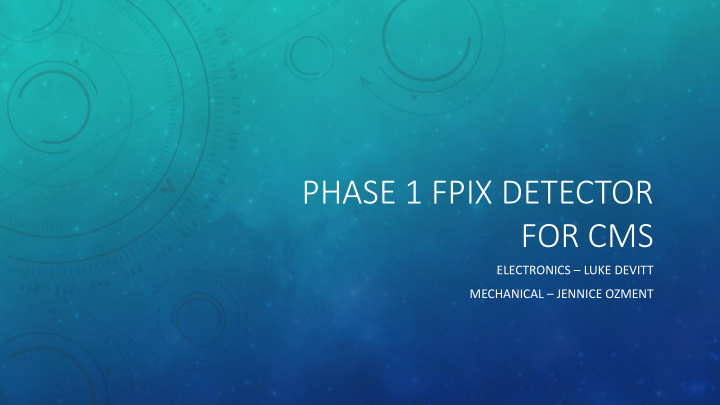



PHASE 1 FPIX DETECTOR FOR CMS ELECTRONICS – LUKE DEVITT MECHANICAL – JENNICE OZMENT
BACKGROUND • LHC increased energy from 7 TeV to 13 TeV in 2015. Current pixel detector is over 6 years old, high luminosities are expected in 2017. This impacts efficiency and pattern recognition. • New forward pixel detector designed and built at Fermilab • This detector will be right at the heart of where the collisions take place • The detector is made of 4 half cylinders (HC)
OVERVIEW OF CMS DETECTOR
CURRENT DETECTOR VS. NEW DETECTOR New Detector - Current Detector Improved track reconstruction and resolution • • 4 blade assemblies 6 blade assemblies - Improved track resolution and efficiency • 2 phase CO 2 Cooling • Cold Water • Graphite and carbon fiber • Be/Al • 4 layers of silicon modules in barrel • 3 layers of silicon modules in barrel • 672 silicon modules at an angle • 672 silicon modules mounted flat • Approximately $639,000 for one HC, parts and labor only – no design , no pre-production, no prototypes
OLD VS. NEW PIXEL DETECTOR
DETAILS – BLADE AND MODULE ASSEMBLIES • Move more of the material/electronics further from the IP • One module type (2x8), that can be removed from blade if needed • Independently mounted inner and outer half disk, inner half disk can be replaced if needed • Takes approximately 360 man hours to build out one blade assembly
BLADES BEFORE RING PLACEMENT
TEMPLATES FOR BLADE PLACEMENT IN RING
COOLING TUBING PLACED IN RINGS
INSIDE AND OUTSIDE BLADE ASSEMBLIES
Electronics DC-DC converters step down voltage for the electronics. 12 each
Port cards have an input high voltage (~100-600V) that allows the sensors to be sensitive to charged particles, they convert electrical signals into optical signals. Port cards talk to and control the modules. 12 each
Filter boards are for power. 15 each
CCU - Is for talking to all the port cards and controlling what they do. It seems to run the show. It can talk to one port card at a time or multiple.
TESTING STAND
CABLES
ELECTRONICS
ELECTRONICS
ELECTRONICS
MECHANICAL • Thermal testing of carbon fiber blades • Thermal testing data evaluation and consolidation • Thermal testing of completed blade assemblies • Installation of Resistance Temperature Detectors (RTDs)
THERMAL TESTING OF CARBON FIBER BLADE ASSEMBLIES
THERMAL TESTING CONTINUED
TEST RESULTS
DATA CONSOLIDATION Marker Info for MO5 20160518 Label Min Avg Max Stdev Unit IR imagenumber Avg System Temperature Blade 17 -12.4 -11.6 -10.5 0.37°C 159 -19.34 +/-1.34 Blade 16 -13.7 -12.7 -11.7 0.46°C 159 Blade 15 -12.7 -11.7 -11 0.36°C 159 Blade 14 -12.7 -11.7 -11 0.38°C 159 Blade 13 -13.8 -13 -12 0.37°C 159 Blade 12 -13.8 -13.1 -12.3 0.29°C 159 Blade 11 -13.7 -12.9 -12.2 0.36°C 159 Blade 10 -14.1 -13.1 -12.3 0.4°C 159 Blade 9 -19.1 -15.1 -13.9 0.72°C 154 Blade 8 -15.4 -14.5 -13.7 0.4°C 154 Blade 7 -15.8 -14.4 -13.3 0.5°C 154 Blade 6 -15.3 -14.2 -13.1 0.49°C 154 Blade 5 -14.8 -13.9 -12.7 0.41°C 154 Blade 4 -13.8 -13.1 -12.2 0.37°C 154 Blade 3 -14.2 -13.1 -12.1 0.41°C 154 Blade 2 -14.6 -13.7 -12.7 0.41°C 154 Blade 1 -14.7 -12.8 -11.4 0.6°C 154
RTDS • Wrap RTD in kapton tape to prevent shorts • Slide RTD into slot, syringe in TF52, then epoxy RTD in place • Attach aluminum block to CO2 supply/return lines with TF52, tie on with aluminum wire, and then epoxy in place
THERMAL TESTING OF COMPLETED BLADE ASSEMBLIES
THERMAL TESTING CONTINUED Blade Number/Module vs. ∆T ( ◦ C) for PO2 Top Modules Bottom Modules 7.5 7 6.5 6 5.5 5 4.5 ∆T (◦ C) 4 3.5 3 2.5 2 1.5 1 0.5 0 1 3 5 7 9 11 13 15 17 Blade Number
BUILD OUT OF HALF CYLINDER 1
BUILD OUT OF HALF CYLINDER 1
BUILD OUT OF HALF CYLINDER 1
TEACHER WORKSHOP AT WAUBONSEE COLLEGE • Learned about gravitational waves, neutrinos, and CMS detector • Learned about quarknet and did some activities from quarknet (iSpy) • Did some histogram activities – dice rolling and the pennies • Homework answer portion was beneficial • Speakers and presentations were excellent
THANK YOU • First, thank you to our mentors, we wouldn’t be here without you • Second, thank you to Fermilab for offering and sponsoring this program, it has been an incredible experience • Teacher resource center is wonderful, great place to find help • Our mentors, Petra and Stefan, were fantastic, patient, and fun • Everyone we worked with was helpful, knowledgeable, and professional
TAKEAWAYS - OZMENT • Now have the knowledge and confidence to talk about fundamental particles • Will introduce basic particle physics concepts to Honor’s Chemistry Students during the atomic structure unit • Will present her experiences here at Fermilab with her students, the science department at Walton, the Walton administration, and the Cobb County School science teachers on our professional development day
TAKEAWAYS - DEVITT • Much more confident in existing knowledge • Will continue to show the standard model to Chemistry classes • Will continue doing cloud chambers with Physics I, and adding a few days of particle physics and histogram activities • Spends 8 weeks on particle physics in Physics II, will continue and add this years experiences to the unit. • Will continue using Quark Workbench
THE END
Recommend
More recommend